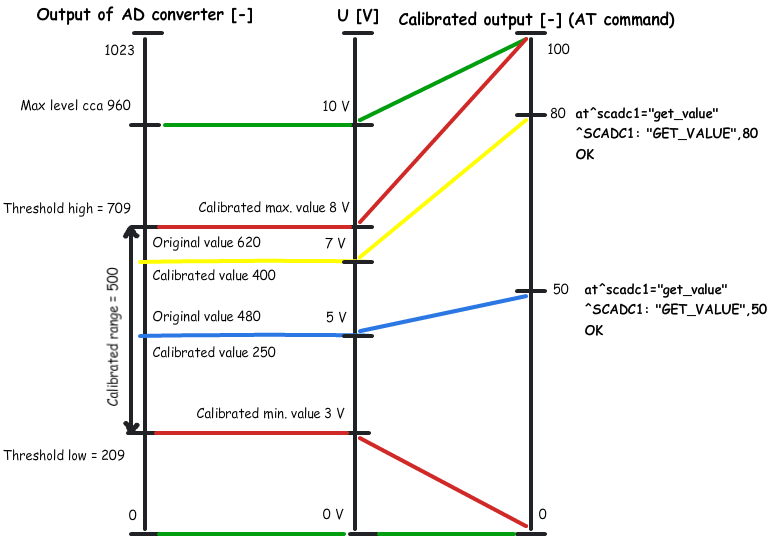3.4 Input Calibration
An A/D converter is connected to the IN1, IN2 and IN3 input terminals to convert the measured value to a number from the range of 0–4096.
The calibration need is based on the component tolerance and external factors. Therefore, we cannot claim for sure that the A/D converter value 4096 is set exactly to 10 V for every terminal. This is impracticable and so the value may slightly vary around this point. For example, suppose there are two terminals located next to each other under identical external conditions. One terminal measures 4090 and the other 4095 for 10 V. This is why the input has to be calibrated precisely to avoid such inconsistence.
Note
- Keep in mind that an uncalibrated input is not non-functional. It is able to measure and read values less precisely, but sufficiently for rough voltage or current detection.
For calibration, use the terminals and AT commands described in S. 6 or the Terminal Config tool – refer to Subs. 4.3 for setting and application details. The figure below shows the calibration diagram and basic principle. The meanings of the curves are explained below.
Figure: Calibration Diagram
– The green lines indicate that no calibration has been made yet. The A/D converter works in the whole range and deviations may occur from the actual value measured on the input. If you, in this situation, set Threshold low to 0 V and Threshold high to 10 V on the input, the terminal will be calibrated for 10 V precisely. For 0 on the input, the AT command will return 0. For 10, you will obtain 100. Thus, the calibrated input can be considered 0–100 % of the calibrated range.
– The red lines mean that the input has been calibrated for 5 V in the interval of 3 to 8 V. This range now represents new measurement limits. If you apply 3 V or less to the input, you are in the calibrated min area and the AT command will return 0. If you apply 8 V or more, you are in the calibrated max area and the AT command will return 100. This means that the measured range width has narrowed by 50 % and 0–100 % is now mapped to the input range of 3–8 V.
– The blue line is an example of measuring in the calibrated range of 0 to 10 V. Apply precisely one half of the calibrated voltage, i.e. 5 V, to the input. The AT command will return 50, i.e. one half of the 0–100 range again. In this case, 5 V is the centre of the calibrated range. If, however, the range was shifted, the value would be shifted too as shown below.
– The yellow line shows that 7 V is applied to the input. In case you measure 7 V in the calibrated 10 V range, the AT command will return 70 as 7 V represents 70 % of the calibrated range. But if the range is just 5 V, 7 V in the range of 3–8 will represent 80 % of the calibrated range and the AT command will return 80.
Caution
- If you use the calibrated input for reading logic values, keep in mind that the calibrated area is considered unstable. Values lower than the set minimum will be 0 and those exceeding the maximum will be 1. No value is guaranteed in an unstable area and a spurious state change may occur any time in the interval. Practically, the decisive level is near the middle of the set interval.

